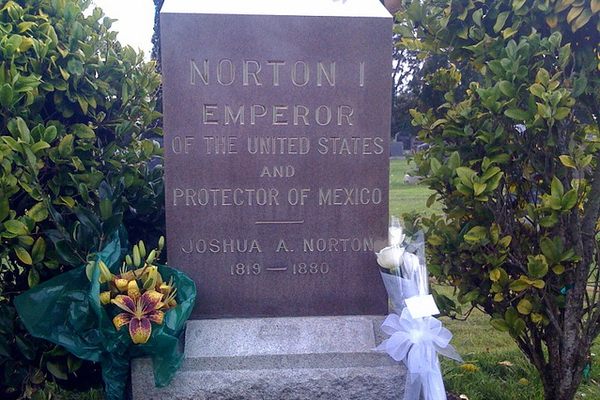Society Adventures: All Soul’s Day After Dark at Colma’s Woodlawn Cemetery
On the evening of All Soul’s Day we took an after dark exploration of the beautiful grounds and darkened crypts at Woodlawn Cemetery in Colma, California.
Woodlawn Memorial Park, now part of the Dignity Memorial network, was established in 1904 as the Masonic Cemetery in Colma after San Francisco passed the ordinance for all cemeteries to move their bodies and monuments. Nestled within the Seven Mile House stagecoach route as well as street car routes and conveniently located near the Southern Pacific Railroad station, Woodlawn quickly became a popular place of interment. Today, many vestiges of its Masonic roots remain, but Woodlawn is now a non-denominational cemetery serving the San Francisco Bay area.
The imposing “Castle” acts as the cemetery’s entry gate, as well as serving as the crypt and columbarium.

The Obscura Society group was warmly greeted by funeral arranger and embalmer Melchor Garza, who was our very knowledgeable and affable guide for the evening.
With the help of maps and information packets prepared by Woodlawn’s administrative assistant Stephanny Castellanos, we toured the grounds and visited the graves of some of Woodlawn’s most notable residents, including cattle king Henry Miller, whiskey distiller Anson Hotaling, dairy farmer turned business man and community leader John Daly, and of course the Emperor of the United States and Protector of Mexico himself, Joshua Norton.
We began wandering the grounds just as the sun went down. Quickly, near complete darkness settled over the cemetery, and we explored by flashlight.
Grave of Emperor Norton
We paused to hear the stories behind several of the significant monuments, and learned a little bit about the lives of those who are buried here, many of whom were moved from earlier interments within the city limits of San Francisco. Emperor Joshua Norton may be the most well known, but his tombstone is modest.
A ferocious beast looks out over the lights of Colma from the mass grave, moved from San Francisco’s Masonic Cemetery.
At the conclusion of our wanderings, we converged back in the oldest section of the 100-year-old blue granite castle, where in the old columbarium, surrounded by the beautiful niches filled with various styles of urns, we learned more about cremation and burial traditions and shared ghost stories while enjoying the evening’s refreshments: hot mulled cider and traditional recipe Victorian funeral biscuits and All Soul’s Cakes. After we were warmed up and sated, Melchor Garza then took us on a tour of the newest parts of the castle, more columbaria, and a beautiful lower level crypt.
We prepared two traditional funereal baked snacks for the evening — these are All Soul’s Cakes, which date back to a medieval tradition of paying beggars with little cakes in exchange for prayers for the dead.
We gathered here in the old columbarium inside the castle for snacks and San Francisco ghost stories on Mark Twain, Ambrose Bierce, and our guests’ spooky childhoods.
At the end of the evening, we took a final walk in quiet and darkened hallways and stairwells, down into the castle’s crypt.
During the evening we saw many beautiful monuments, mausoleums, columbaria, and crypts. We visited the final resting places of famous San Franciscans and learned some things about them we may not have known before, such as Henry Miller’s birth name being Heinrich Kreiser, while Henry Miller was the name on the non-transferable steamer ticket he purchased from a friend in New York. We learned that the 1906 San Francisco earthquake left two blocks of Jackson Street unscathed prompting the jingle: “If as they say God spanked the town for being over frisky, why did he burn the churches down and spare Hotaling’s whiskey?” We also learned that Emperor Norton was born in London, but came to San Francisco from South Africa to seek his fortune, which he promptly lost and soon thereafter went mad.
We learned that Garza’s office is in what was at one time the elevator shaft for transporting the dead to the lower level crypt and that the Woodlawn staff prefers to spend as little time as possible in the filing room adjacent to the old columbarium — where unnerving activity is said to take place.
Although our after hours visit was arranged specially, Woodlawn is open for curious visitors Mon-Fri 8am-5pm, 8:30-4:30 on weekends. We recommend stopping in the office first to get a map or directions to some of the significant burials. Details here: Woodlawn Memorial Park Additional maps and more information about Colma’s cemeteries can be obtained at the offices of the Colma Historical Association, just a few blocks away.
A big thank you to Mel and Stephanny for making our visit so marvelous, and extra special thanks to Hector Gonzalez, GM at Woodlawn, without whose generous assistance this event never would have been possible.
All photographs by Annetta Black for Atlas Obscura.
The Obscura Society is the real-world exploration arm of Atlas Obscura We seek out secret histories, unusual access, and opportunities for our community to explore strange and overlooked places hidden all around us. Join us on our next adventure!
All Upcoming Obscura Society Events
If you’d like to be notified about future San Francisco Bay Area events, be sure to join our Obscura Society Bay Area Events Announcement List and join our local community pages on Facebook
Facebook: Obscura Society San Francisco














Follow us on Twitter to get the latest on the world's hidden wonders.
Like us on Facebook to get the latest on the world's hidden wonders.
Follow us on Twitter Like us on Facebook